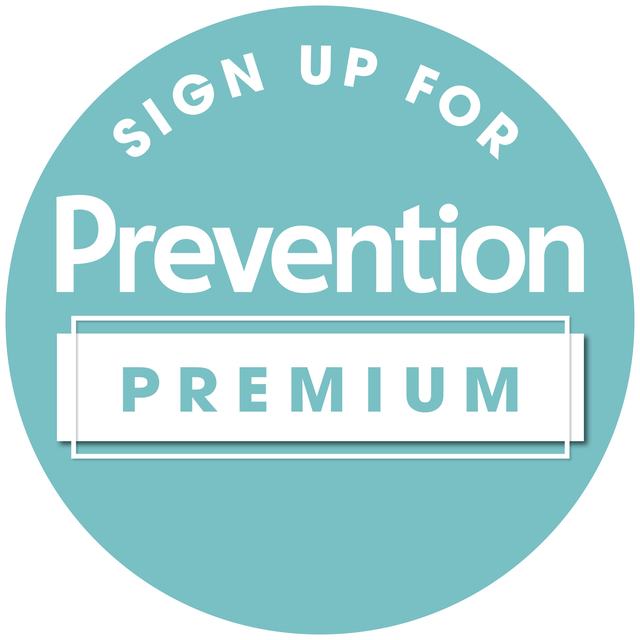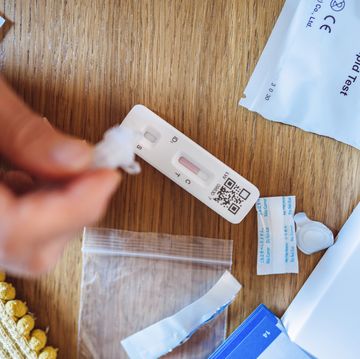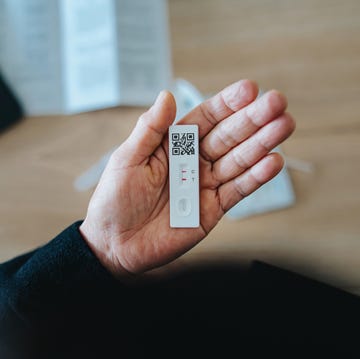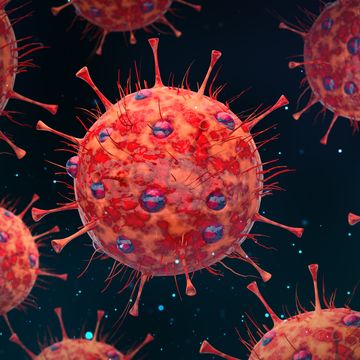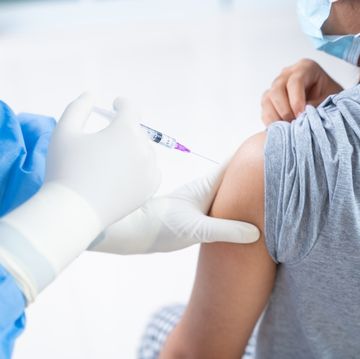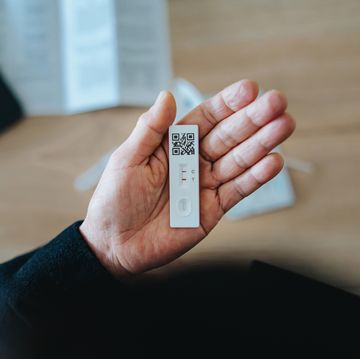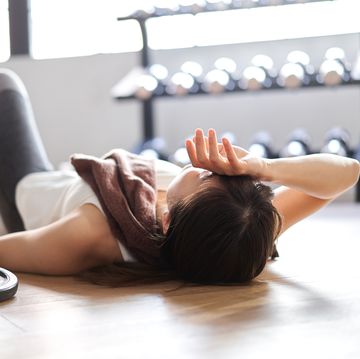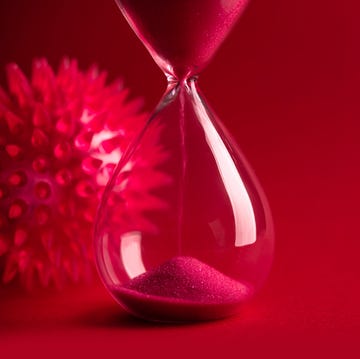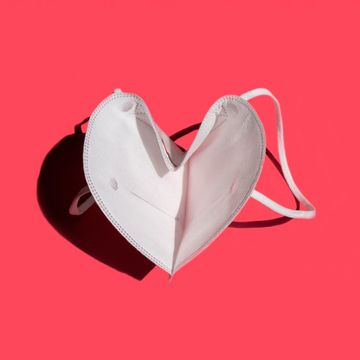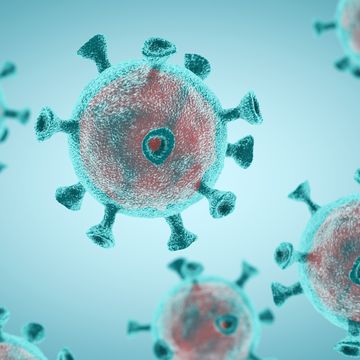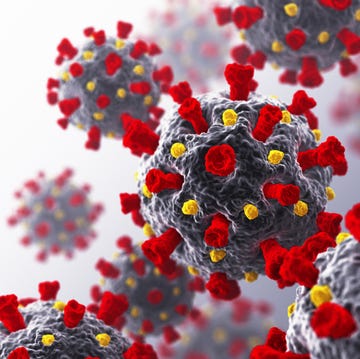COVID-19 has been linked with a slew of unusual symptoms, including COVID toes and COVID tongue. But there’s another weird one that keeps coming up on social media: back pain due to COVID.
Twitter is flooded with comments from people who said they’ve either had intense back pain while dealing with COVID-19 or suspect that back pain they developed after having the virus could be a symptom of long COVID.
Ellen Degeneres spoke out about this back in 2020, saying in a video shared to Twitter that she struggled with back pain when she had the virus. “One thing they don’t tell you is you get, somehow, excruciating back pain,” she said. “Who knew? How come?”
Although the Centers for Disease Control and Prevention (CDC) doesn’t specifically list back pain as a COVID-19 symptom, the agency does include muscle pain and body aches as a sign to look out for. So, should you be worried about COVID-19 if you’re experiencing back pain? Not necessarily. Here’s what to know, according to doctors.
Is back pain a common symptom of COVID-19?
A survey conducted by Survivor Corps, a Facebook support group for COVID-19 survivors, and Natalie Lambert, Ph.D., of Indiana University’s School of Medicine, found COVID-19 “long-haulers”—people who have technically recovered from COVID-19, but still experience long-term symptoms or side effects—reported experiencing lower-, upper-, and mid-back pain.
Back pain due to COVID-19 is grouped in with general muscle aches or pains, which the CDC lists as an official symptom. A February 2020 report from the World Health Organization (WHO) analyzed nearly 56,000 cases of COVID-19 in China, and found that nearly 15% of patients experienced muscle aches and pains.
“COVID-19, like other viruses, will cause systemic symptoms,” says Marcus Duda, M.D., orthopedic surgeon and founder of Vive Wear. “Similar to having the flu, COVID-19 may cause generalized achiness throughout the body.”
Why does COVID-19 sometimes cause back pain?
When you get sick, your body sets off an immune response to fight off what doesn’t belong there, such as harmful bacteria or viruses. “The joint pain in the back and legs is due to the body’s inflammatory response to the virus,” Dr. Duda says. “These viral infections cause shaking, chills, body aches, and difficult mobility.”
More specifically, the muscle aches and pains are “a result of cells of the immune system releasing interleukins, which are proteins that help in the fight against invading pathogens,” Richard Watkins, M.D., infectious disease physician and professor of internal medicine at the Northeast Ohio Medical University, previously told Prevention.
What does back pain due to COVID-19 feel like?
If you have muscle pain paired with symptoms like a fever, dry cough, loss of taste or smell, sore throat, headache, or aches in other areas, it could be a sign of COVID-19. This form of back pain feels “like cramping or spasming of the back muscles,” Dr. Duda says.
“COVID-19 is unique because it causes an increased inflammatory response in the lungs and brain,” he says. “That is why those with COVID-19 can have prolonged headaches for months after the virus has resolved and why people sometimes require oxygen or ventilatory support.”
In general, the aches and pains you feel from COVID-19 feel much different than the soreness you’d feel after, say, intense exercise. “The pain from working out tends to go away after a few hours, but can persist for days with COVID-19,” Dr. Watkins said.
Can you tell if your back pain is from COVID?
Not necessarily. Back pain is one of the most common medical problems in the U.S., impacting eight out of 10 people in their lifetime, according to Medline Plus. Given how many people struggle with back pain, it’s tricky to know for sure if your pain is from COVID or one of the many other common causes that can lead to back aches, says Thomas Russo, M.D., professor and chief of infectious disease at the University at Buffalo in New York.
“The overwhelming number of people that have back pain do not have COVID,” Dr. Russo says. But, he adds, it’s important to look at your back pain in the context of everything else that’s going on with your health. “If you have symptoms of COVID-19 in addition to back pain that are more common with COVID, such as respiratory tract symptoms and loss of taste and smell, that would be a signal that your back pain could be due to COVID,” he says.
He also recommends suspecting COVID if you suddenly develop back pain and you know you’ve recently been exposed to someone with the virus. “But back pain alone, without anything else, should not make you suspect COVID,” Dr. Russo says.
Really, the only way to know if your back pain might be linked to COVID is to test yourself, Dr. Russo says. “The best thing to do to ease your concerns is to go ahead and get tested,” he says. “That’s a way to evaluate this more objectively.”
Is back pain a symptom of long-haul COVID?
Long-haul COVID, also known as long COVID and post-COVID conditions, is a broad term used to describe new, returning, or ongoing health problems people can experience four or more weeks they’ve first been infected with SARS-CoV-2, the virus that causes COVID-19, according to the Centers for Disease Control and Prevention (CDC).
Researchers and doctors are still learning about long COVID but the CDC says the following are some of the more common symptoms of the condition:
· Difficulty breathing or shortness of breath
· Tiredness or fatigue
· Symptoms that get worse after physical or mental activities
· Difficulty thinking or concentrating
· Cough
· Chest or stomach pain
· Headache
· Fast-beating or pounding heart
· Joint or muscle pain
· Pins-and-needles feeling
· Diarrhea
· Sleep problems
· Fever
· Dizziness on standing
· Rash
· Mood changes
· Change in smell or taste
· Changes in menstrual period cycles
While the list doesn’t explicitly mention back pain, “joint or muscle pain” definitely is a broad category that can encompass it. “Some people with long COVID report chronic pain,” says infectious disease expert Amesh A. Adalja, M.D., a senior scholar at the Johns Hopkins Center for Health Security. “But it’s unclear whether this is actually more common in long COVID patients because most studies do not have control groups.”
Still, Kathryn A. Boling, M.D., a primary care physician at Baltimore's Mercy Medical Center, says she’s seen this in patients. “We don’t understand long COVID completely but could you have back pain related to COVID? You could,” she says. Dr. Boling says that most of her patients who have had COVID-19 and are experiencing back pain will often feel it in the same area as their lungs. “It’s not necessarily a lower back pain or pain in the neck—it’s more in the middle of the back,” she says. “It’s likely radiating from the respiratory system.”
Are there other pandemic-related reasons for back pain?
There can be. The pandemic has caused a shift in several behaviors, and those can cause people to develop back pain, Dr. Boling says. They include:
- Being more sedentary. “If you lay around, you’re much more likely to stiffen up a bit,” Dr. Boling says. “And, when you’re stiff, you’re more likely to pull a muscle in your back or feel some tightness.” Research has found a link between being stuck at home under quarantine and back pain: One 2020 study of people in Saudi Arabia found that 38.8% of people reported having lower back pain before going into quarantine while 43.8% said they had back pain after.
- Working from home.While plenty of people have returned to offices, that hasn’t been the case for everyone. “Just getting up, getting dressed, and going to work involves activity that moves the muscles around and makes them less stiff,” Dr. Boling says. Your seating situation may also not be as ergonomic at home as it is at work, raising the risk that you’ll develop stiffness and aches that could lead to back pain, she says. One study published in 2021 found that 30% of people in Malta said they had chronic lower back pain pre-pandemic, and 49% had it afterward—and remote working may have been a contributing factor.
- Stress. Stress has been huge over the past two years, and that can lead to serious aches and pain, Dr. Boling says. “When you’re stressed, you tighten up everywhere,” she explains. “That raises your risk of an injury.”
Bottom line: Having back pain doesn’t automatically mean you have COVID-19.
Although aches and pains can be a sign of COVID-19, other conditions or injuries are more commonly associated with back pain, including sitting too much and poor posture, which you may be dealing with if you’ve been working from home. A sports injury, arthritis, a bulging disc in the spine, or osteoporosis could also be to blame.
If your back pain persists more than a few weeks, becomes more severe over time, or is accompanied by unexplained weight loss or numbness in the limbs, talk to your doctor to ensure a proper diagnosis.
If you have other signs of COVID-19, your doctor can guide you on getting tested and explain how to treat your symptoms at home if your illness is considered mild. Dr. Duda recommends taking acetaminophen (Tylenol), which will reduce pain and fever, and applying a heating pad to the back to help relieve aches and spasming. Getting plenty of rest and staying hydrated will be helpful, too.
As you recover, note that body aches from COVID-19 can linger for up to two weeks for most people, Dr. Watkins said, but rest assured “the muscle pain usually isn’t incapacitating.”

Currently an assistant editor at Prevention.com, Nicol is a Manhattan-based journalist who specializes in health, wellness, beauty, fashion, business, and lifestyle. Her work has appeared in Women’s Health, Good Housekeeping, Woman’s Day, Houston Chronicle, Business Insider, INSIDER, Everyday Health, and more. When Nicol isn't writing, she loves trying new workout classes, testing out the latest face mask, and traveling. Follow her on Instagram for the latest on health, wellness, and lifestyle.

